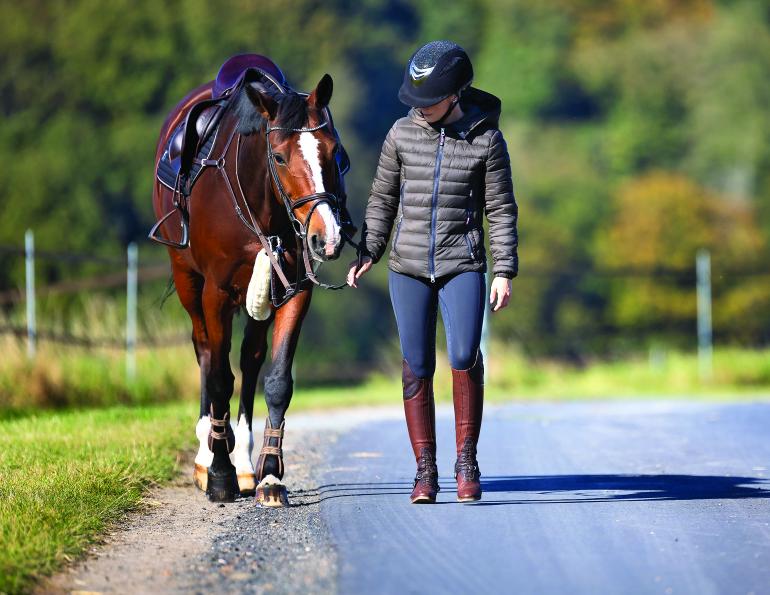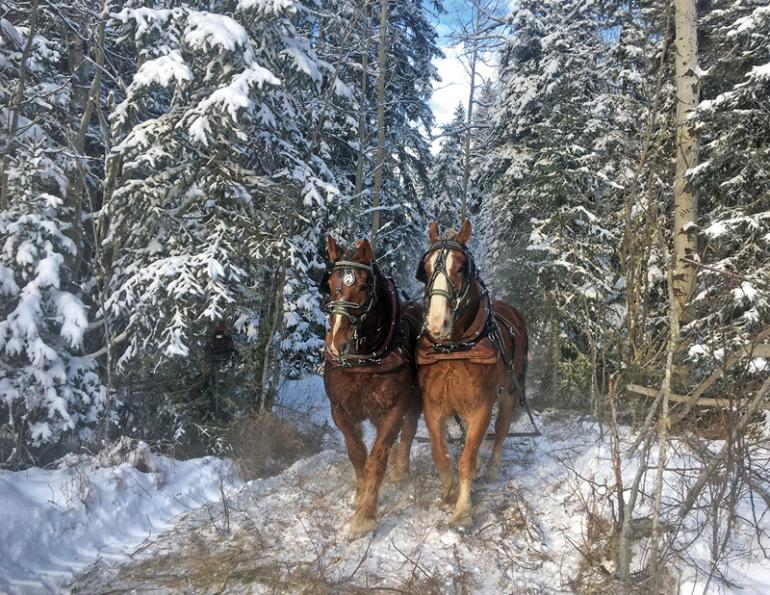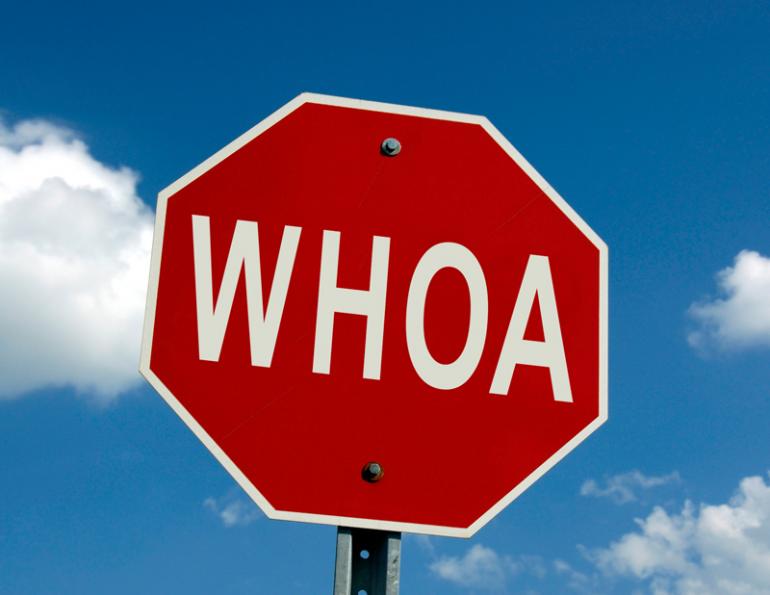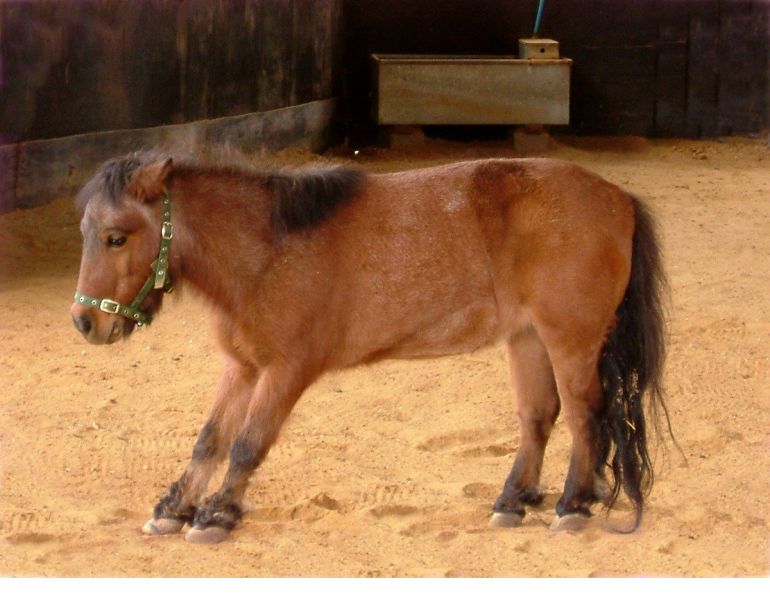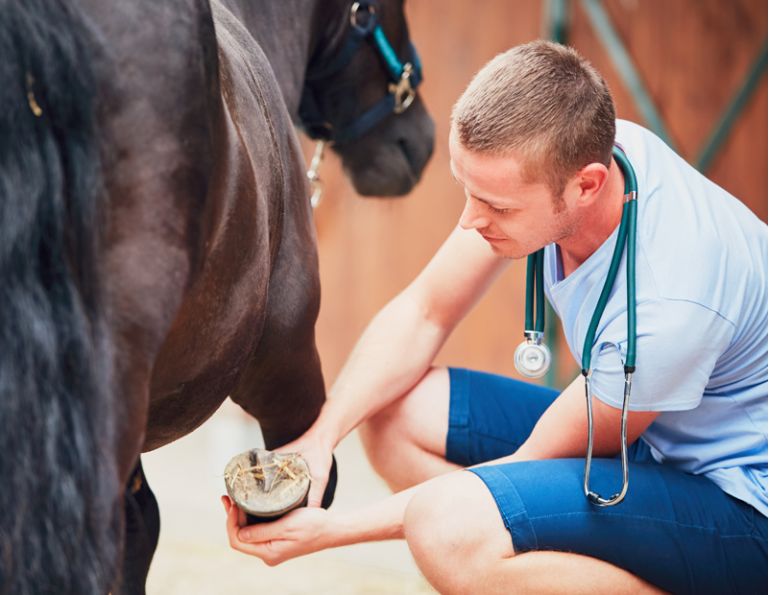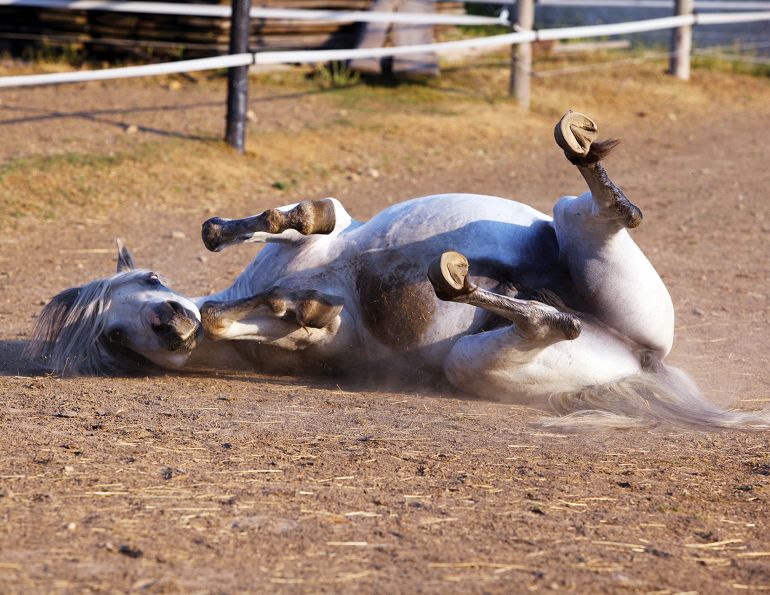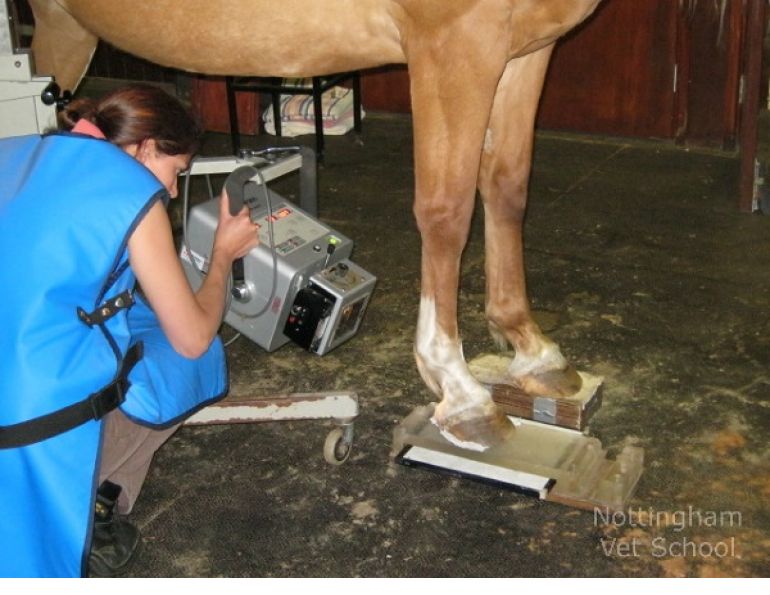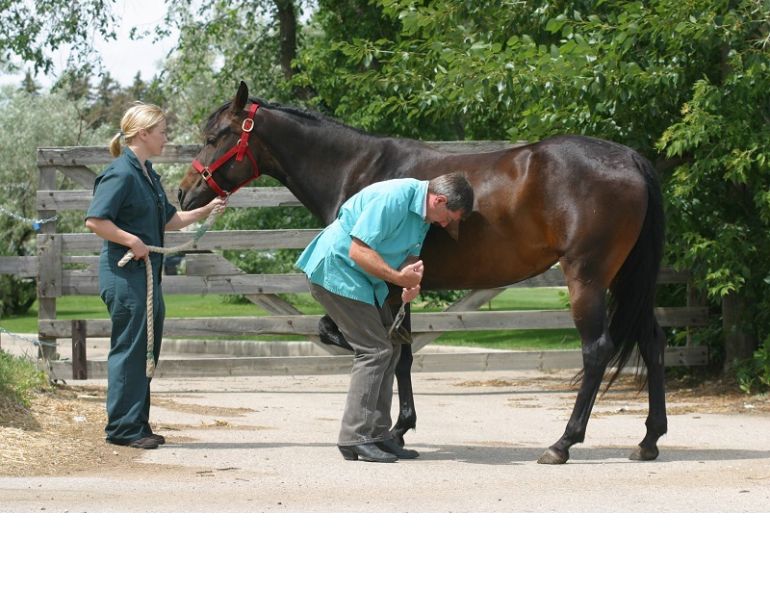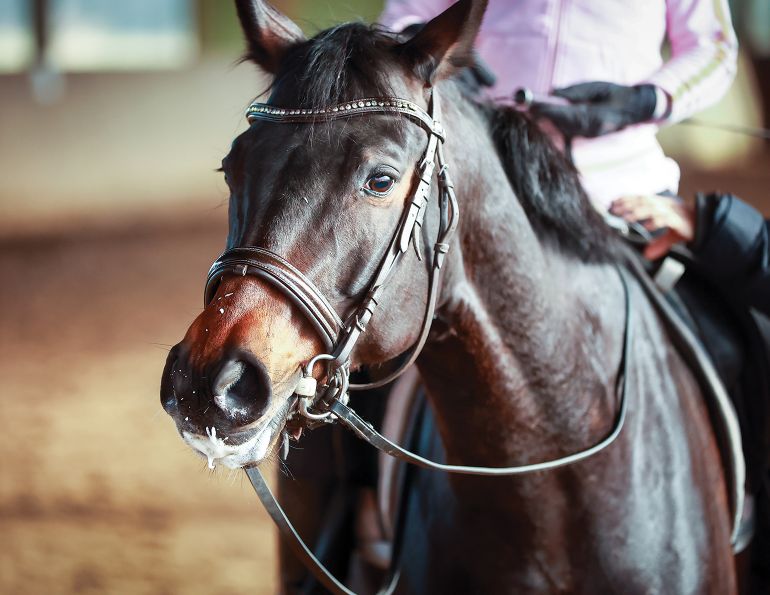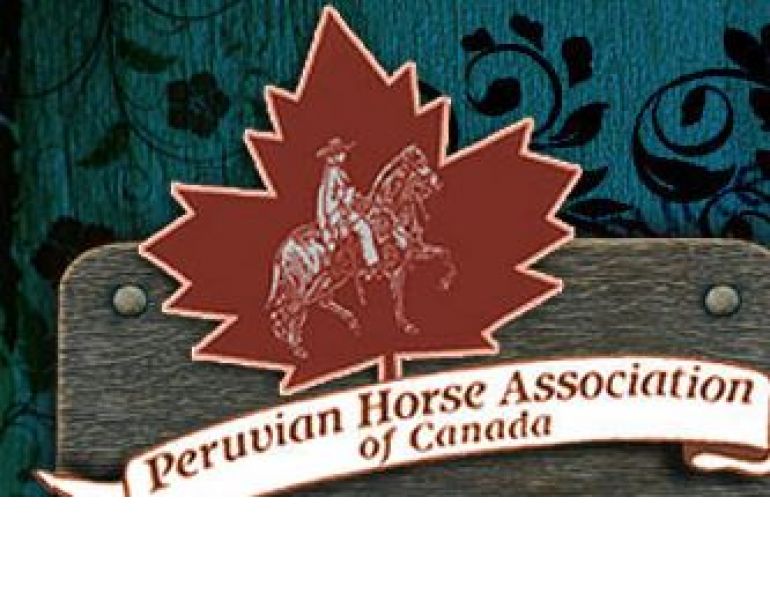By Katy White, DVM, BSc., Burwash Equine Services
One of the most common conditions affecting soundness and performance lifespan of horses is osteoarthritis (OA), with some reports suggesting 60 percent of lameness issues in horses is attributable to OA(1). OA is known across animal and human populations to cause stiff and creaky joint movement. It can make getting up in the morning difficult or slow you down the day after a long run.
OA is a slow, progressive disease of the joint including damage to the articular cartilage, the bone underneath the cartilage, and local soft tissue structures including the joint capsule and supporting ligaments. OA does not affect all horses equally, with genetics, environment, diet, and type of stress/strain on the joint each playing a role in both the progression and severity of the joint disease. From acute injury to general wear and tear, OA can offer in its severity and the speed of progression. With the cause varying from joint-to-joint and horse-to-horse, complete understanding and, therefore, prevention of the disease has been limited. In addition, every individual horse has a different pain tolerance, some exercising through OA and others showing performance-limiting lameness. The difficult thing about OA compared to other diseases is that once the process has started it cannot be reversed, meaning it cannot be cured and we are instead limited to management. The good news is that advances in veterinary diagnosis and management of joint disease have progressed significantly in recent years, allowing us to identify OA earlier and better support our patients and clients to keep them doing what they love for longer while minimizing any associated discomfort.
Being a common condition of aging horses, OA may be the first thing one considers when dealing with lameness or performance issues. Even so, the importance of an accurate diagnosis cannot be overstated. The critical first step in identifying and managing OA is clinical examination to identify the signs, including heat, swelling, lameness, excess joint fluid, or decreased range of motion. Diagnosis may be aided by diagnostic nerve blocks or imaging such as x-ray, ultrasound, nuclear scintigraphy, magnetic resonance imaging (MRI), and computed tomography (CT) to help localize the cause of the lameness and the severity of the joint disease. It is important to rule out other potential causes of lameness so that treatment can be directed towards the primary source of the issue and have the best effect. For example, joint injections will not help a horse with a soft tissue injury such as a bowed tendon. It may in fact exacerbate the injury by masking the pain and inflammation in the leg, causing the horse to injure it further. Working with your veterinarian, a lameness exam and further diagnostics will help to ensure that you are dealing with OA in your sore horse and not a more acute condition that requires alternative treatment.
Related: An Inside Look at Joints
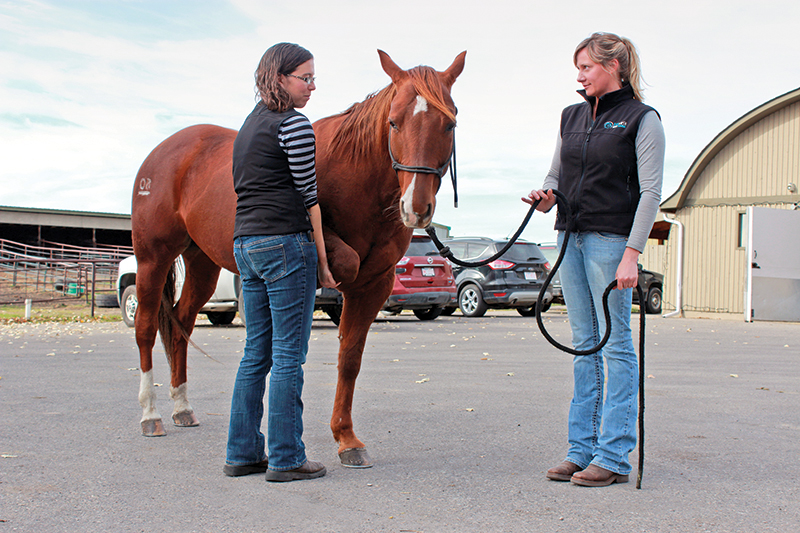
Dr. Crystal Lee, DVM, DACVS at Burwash Equine Services performing a lameness exam on a horse. She is flexing the upper right forelimb in this photo to assess for joint pain. Photo courtesy of Burwash Equine Services
Once your horse has been diagnosed with OA, your veterinarian will help you come up with a treatment and management plan specific to your horse. A multimodal treatment plan including regular exercise is advocated for the management of OA. While it may seem counterintuitive, embracing exercise within a structured program will help to maintain joint health. Regular exercise and rest help to maintain an anti-inflammatory state within the body. Maintaining muscle mass will also help to stabilize affected joints and prevent uneven load bearing. A slow warm-up and cooldown are essential to help ensure the horse is moving well and comfortably before being asked to perform more advanced tasks. A minimum of 15 to 20 minutes of warm-up is ideal, starting with “long and low” walk and progressing to a more correct and balanced walk with engagement of the core and hind end to help set the horse up for success throughout the exercise session. Stretching through a series of passive flexion/extension movements prior to and after exercise can also be helpful in maintaining flexibility and range of motion in OA affected joints. Finally, your veterinarian will be able to help direct which type of exercise is best for your horse depending on the location and severity of OA. For example, limiting concussive work on hard surfaces may be helpful while trying to maximize time on softer footing. Type of movement, including sharp turns, sudden stops, starts, or hard landings may also be contraindicated for horses with OA. Alternative exercise such as swimming is one option for encouraging movement and exercise without the concussive effects that one may be trying to avoid. Cryotherapy or using ice on affected joints after particularly intense exercise sessions can also help to minimize inflammation. In advanced cases, it is also important to keep realistic expectations. As the disease is progressive, it may get to the point that higher-level performance is no longer possible and turnout in a field with light daily exercise is the best option.
Related: Osteoarthritis of the Equine TMJ
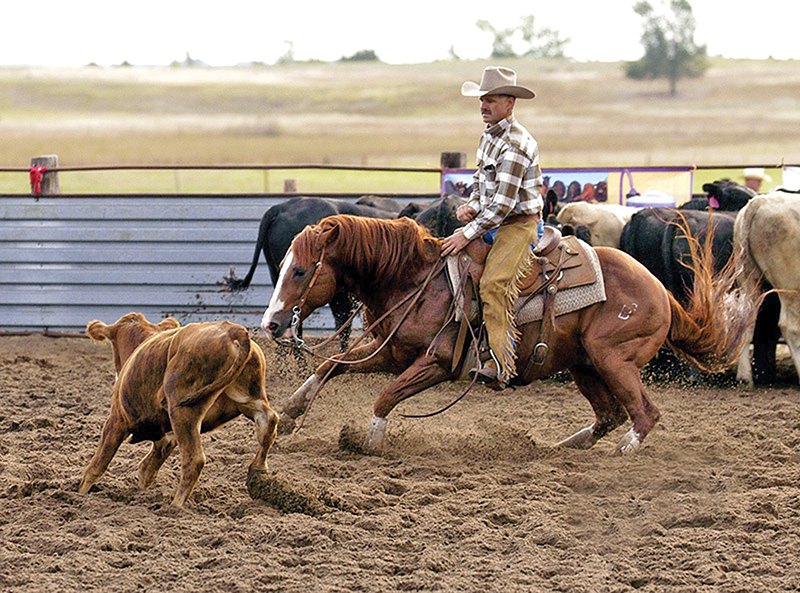
Movement involving sharp turns and sudden stops may be ill-advised for the horse with osteoarthritis. Photo: Shutterstock/Dale A Stork
Appropriate farriery is also crucial to supporting horses with OA. Something as simple as a long toe can put unnecessary strain on the joints, ligaments, and tendons. Regardless of which joint in the limb is affected by OA, correct trimming and potentially therapeutic shoeing of the hoof can help to set the entire limb up for success. For example, horses with conformational abnormalities may be more prone to certain types of OA due to uneven loading of the limb. Your farrier will not be able to reverse the abnormality, but can minimize strain the horse by keeping the foot trimmed to be as balanced as possible and supporting the limb with a therapeutic shoe that encourages breakover on the “stressed” side of the limb. Similarly, in specific types of OA such as navicular syndrome, therapeutic shoes can help to support the associated hoof and soft tissue structures that are concurrently affected, thus minimizing the excess strain on the navicular apparatus and relieving discomfort. Approaching maintenance of soundness as a team with your veterinarian will help to set your farrier up for success by ensuring they have the best information, accurate diagnosis, and appropriate associated images to address the underlying condition and help keep your horse in work.
Nutrition is an essential step in the management of OA. Unfortunately, it can be hard for some owners to recognize that their horse is overweight, with one study finding that over 50 percent of horses presenting at an equine referral hospital over one summer were overweight to obese(2). The added pounds of an overweight horse put more stress and strain on already diseased joints. Not only that, but obesity is known to be linked to increased inflammatory factors in the horse(3). When the body is in a pro-inflammatory state, its ability to deal with already inflamed tissues is limited, exacerbating the OA disease process. As such, in horses with OA it is essential to maintain a healthy body condition. Aiming for a body condition score of 5 based on the Henneke Body Scoring System (see Canadian Horse Journal Winter 2021 issue, page 20) is ideal, with healthy horses falling between 4 and 6. Anything at or above a body condition score of 7 is considered overweight and alteration to the diet may be recommended. In addition, oral joint supplements such as glucosamine, chondroitin sulfate, and/or avocado soy unsaponifiables (ASU) may offer some support for horses with OA(4). It is important to recognize that not all joint supplements are created equal. Horse owners should consult their veterinarians to ensure they are relying on as much evidence as possible in order to administer high-quality supplements that do not interact with other treatments utilized.
An increasing number of veterinary-administered or prescribed treatments are becoming available to help manage horses with OA. The mainstay of treatment for OA for decades has been nonsteroidal anti-inflammatory (NSAID) medications. NSAIDs such as phenylbutazone (Bute), flunixin meglumine (e.g., Banamine®), or firocoxib (e.g., PrevEquine™) can be used for their anti-inflammatory and pain control effects on a systemic level to relieve the discomfort associated with OA. While generally effective and essential in more acute injuries, for long-term administration there can be side effects associated with specific medications, including renal and gastrointestinal insult(5). Alternatively, more directed treatments may be considered as a first step in an attempt to minimize side effects. Systemically administered joint therapies such as hyaluronic acid (e.g., Legend®) and polysulfated glycosaminoglycans (e.g., Adequan®) both have few side effects and are designed to promote healthy joint environment. They are given either in the vein or muscle (respectively) in a series of injections with the aim of helping to prevent progression and treat existing joint disease. While similar, they have different mechanisms of action and either or both may be used depending on your horse’s specific condition(5). Another systemically administered medication that has had proven effects for navicular syndrome is OSPhOS®, an intramuscular injection that plays a role in bone metabolism and has been shown to improve discomfort in affected horses(6).
Related: 10 Things You Might Not Know About Horse Hooves
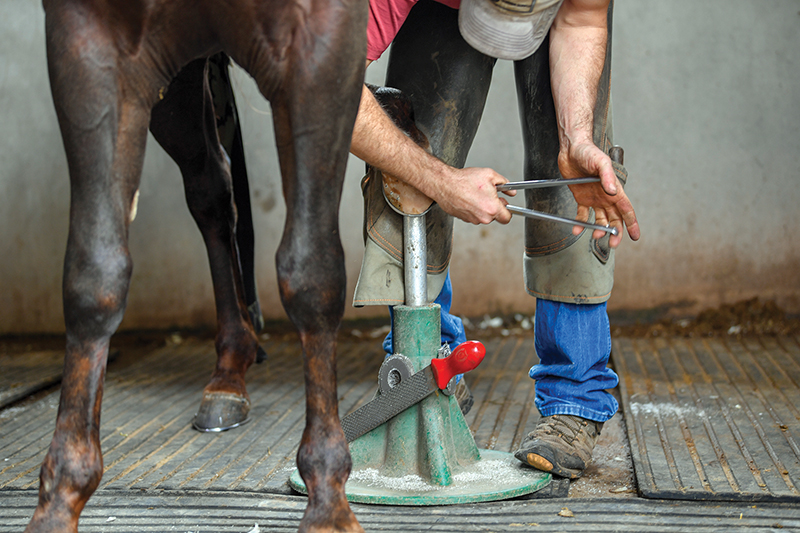
Your farrier is an essential member of the team working to support the horse with osteoarthritis. Photo: Shutterstock/Yuval Goldenshtein
More directed treatment of OA includes intra-articular (IA) treatment or joint injections. When the specific joint is identified in the diagnostic process, a joint injection may be recommended to help provide directed treatment. The gold standard of IA treatment for years has been corticosteroids, with or without a joint lubricant such as hyaluronic acid, with the aim of administering a strong anti-inflammatory medication directly into the affected joint space. Corticosteroids are proven to have strong therapeutic effect and are generally affordable but have the risk of becoming less effective over time. In addition, certain steroids may be associated with undesirable side effects including cartilage degeneration(5). As technology has advanced and our understanding of joint disease has increased, alternative joint medications have become available, offering anti-inflammatory effects while targeting specific components of joint health. One such medication is polyacrylamide gels (PAG) (e.g., Noltrex®Vet or Arthramid®Vet). PAGs are hydrogels that lubricate the joint by coating and binding the cartilage layer, thus helping to reduce friction in the joint space(7). New advances in biologic medications are also at the forefront of OA treatment. Biologics are products that utilize the horse’s own stem cells or blood-derived anti-inflammatory mechanisms to trigger the natural mechanisms for alleviating inflammation and improving joint health. Biologic products are continuously being researched to find the most effective option, with many available including autologous conditioned serum, autologous protein solution, platelet rich plasma, alpha-2 macroglobulin, and mesenchymal stem cells. While each is unique in its exact mechanism, they aim to target specific inflammatory processes known in OA in an attempt to slow down progression and improve joint health. Based on the character, stage, or severity of the horse’s OA, your veterinarian will be able to help direct the best IA treatment, while balancing cost with availability in your area.
Related: Managing the Senior Performance Horse
Alternative therapies may also be considered as an adjunct to the above-described management changes and veterinary treatments. Horses with lameness originating in the limb can be concurrently affected by body or back pain resulting from their abnormal load bearing. While not a specific treatment for OA, manual therapies such as chiropractic or massage therapy may help to relieve some of the compensatory discomfort the horse feels secondary to their OA. While proof of resolution of lameness is limited, there is evidence of benefit in improving muscle tension and stiffness through the body(8). Acupuncture also has some support for use in horses with OA, with evidence for its use as an aide in pain control in cases of acute musculoskeletal pain(9). Other rehabilitative therapies such as laser therapy, therapeutic ultrasound, and/or shockwave therapy may be recommended by your veterinarian as an aide in pain control or healing after an acute injury.
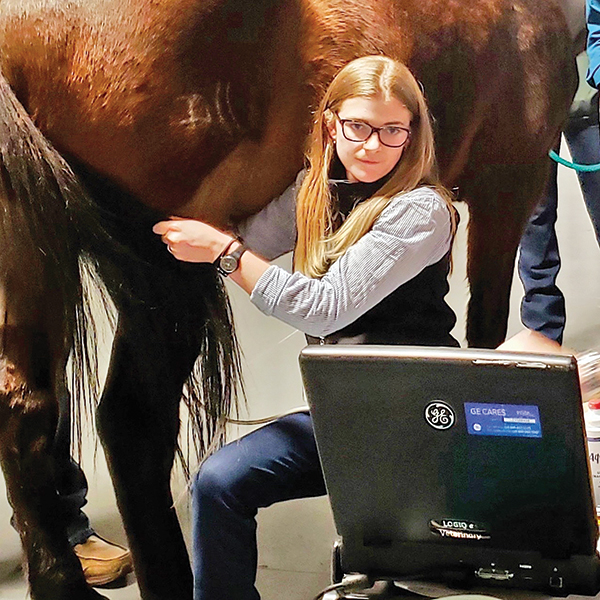
Dr. Katy White performing ultrasound on a stifle joint. Ultrasound can be used to image the joint fluid, menisci, tendons/ligaments, and bone surface of a joint that may be affected in osteoarthritis. Photo courtesy of Burwash Equine Services
Depending on the presentation and severity of your horse’s joint disease, arthroscopic surgery may be recommended. This procedure can be used as both a diagnostic tool to visualize damage present within the joint that was not visible on diagnostic imaging, and as a therapeutic tool to debride unhealthy tissues including bone or cartilage fragments from the joint. In general, arthroscopy is more effective during the early course of disease before a fragment or chip has had a chance to cause extensive inflammation and chronic joint changes. In more chronic or severe instances, it is possible to assist fusion of the joint either chemically or through surgical techniques with the aim of removing the pain associated with movement. In general, horses with OA in low-motion joints, such as pastern or lower hock joints, tend to be better candidates for this procedure with some hope of return to athletic function. For horses with disease in higher motion joints, such as fetlock or coffin joints, surgical intervention is required with the hope that these horses can return to comfort in pasture with limited chance of return to performance.

Photo from an arthroscopy performed by Dr. Crystal Lee, DVM, DACVS at Burwash Equine Services demonstrating an osteochondral fragment in a joint with associated synovial proliferation. Photo courtesy of Burwash Equine Services
Osteoarthritis is a progressive condition of horses that cannot be cured and is best managed through a multimodal approach. Although its progression may be inevitable, with the aid of the many management and treatment techniques described here we are able to lengthen the performance career of today’s horses beyond that of horses in the past that struggled with OA without the benefit of the knowledge and technology advances now available. With each horse being an individual, treatment can be directed towards their specific condition while working as a team with the trainer, farrier, nutritionist, and veterinarian to ensure the horse has the best chance of long-term comfort and athletic ability.
Related: Creating an Equine Fitness Program
References:
- (1) Caron JP, Genovese, RL. Principles and practices of joint disease treatment. In: Ross MW, Dyson S, eds. Diagnosis and Management of Lameness in the Horse, 1st ed. Philadelphia, PA: Saunders, 2003:746–764.
- (2) Thatcher CD, Pleasant RS, Geor RJ, Elvinger F, Negrin KA, Franklin J, Gay L, Werre SR. Prevalence of obesity in mature horses: an equine body condition study. Journal of Animal Physiology and Animal Nutrition. 2008 Apr;92(2):222-.
- (3) Vick MM, Adams AA, Murphy BA, Sessions DR, Horohov DW, Cook RF, Shelton BJ, Fitzgerald BP. Relationships among inflammatory cytokines, obesity, and insulin sensitivity in the horse. Journal of Animal Science. 2007 May 1;85(5):1144-55.
- (4) Oke SL, McIlwraith CW. Review of the Potential Indications and Contraindications for Equine Oral Joint Health Supplements, in Proceedings, 54th Annual AAEP Convention 2008; 261–267.
- (5) McIlwraith CW. Traumatic Joint Injuries and Diseases. Equine Orthopaedic Research Center Orthopaedic Topics, Colorado State University, 2006b.
- (6) Argüelles D, Saitua A, de Medina AS, Muñoz JA, Muñoz A. Clinical efficacy of clodronic acid in horses diagnosed with navicular syndrome: A field study using objective and subjective lameness evaluation. Research in Veterinary Science. 2019 Aug 1;125:298-304.
- (7) Vishwanath K, McClure SR, Bonassar LJ. Polyacrylamide hydrogel lubricates cartilage after biochemical degradation and mechanical injury. Journal of Orthopaedic Research®. 2022 Apr 5.
- (8) Haussler KK. Efficacy of manual therapies in the treatment of thoracolumbar dysfunction. In AAEP Proceedings 2011 (pp. 141-152).
- (9) Hackett GE, Spitzfaden DM, May KJ, Savoldi M, Dodd M. Acupuncture: is it effective for alleviating pain in the horse. Proceedings, 43rd Annual AAEP Convention 1997 Dec (Vol. 43, pp. 333-335).
Related: How to Reduce the Risk of Training Related Injuries
Related: Equine Athleticism - It All Hinges on the Joints
Main Photo: Shutterstock/Rolf Dannenberg



